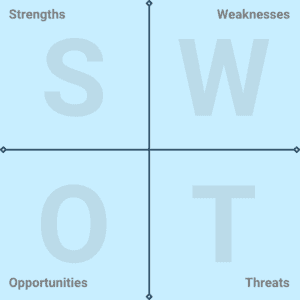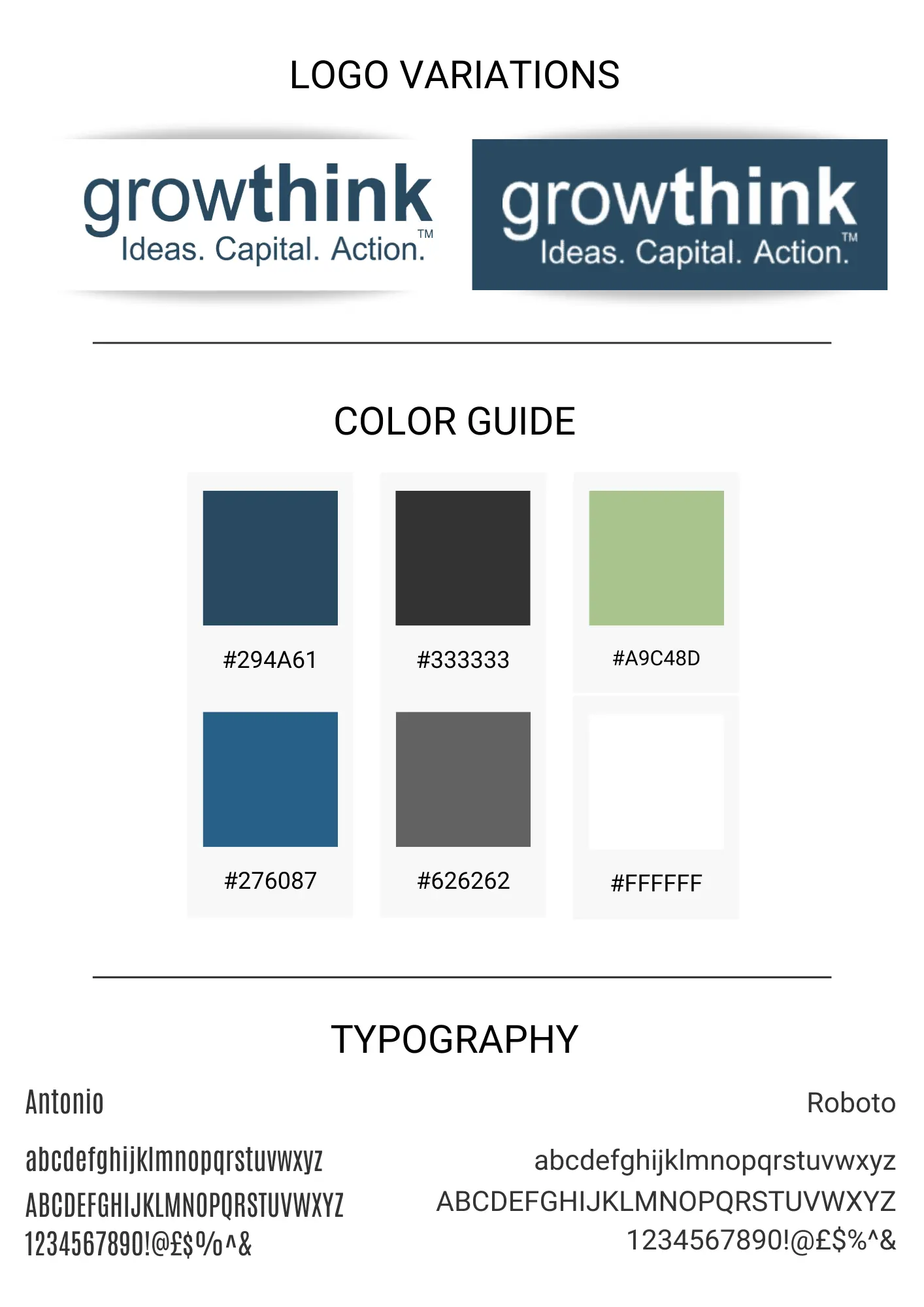What is a Marketing Plan?
A marketing plan is a roadmap that explains how your business will generate more leads and sales. It includes every key marketing strategy that will affect your marketing results from your brand positioning and pricing to your promotional efforts.
It’s important to remember that a marketing plan is not something you create in one sitting. This is an ongoing project that requires research, planning, and revision over time before it can truly be finalized.
Although creating a marketing plan can seem like a daunting task, it can actually be quite simple if you know what information should be included in your marketing plan template and where to find examples. Below you will learn everything you must include in your marketing plan so you can effectively grow your business.
What are the Key Components of a Traditional Marketing Plan?
For a comprehensive marketing plan, you should include the following 11 key components:
- Executive Summary
- Target Market Segments
- Unique Selling Proposition (USP)
- Pricing and Positioning Strategy
- Distribution Strategy
- Offers
- Marketing Materials
- Promotions Strategy
- Digital Marketing Plan
- Conversion, Referral and Retention Strategy
- Financial Projections
Each of these sections is explained in detail below along with examples.
How to Write a Marketing Plan + Examples
- Executive Summary
- What does the marketing plan intend to accomplish? Why?
- Who handles the daily operations and execution of the marketing plan?
- How will you measure success to determine the effectiveness of the marketing plan?
- Target Market Segments
- They prioritize a good bargain over trendy styles.
- They want to spend as little time as possible at the store.
- They shop for children and themselves.
- They use the internet for product comparison, but will still go to stores to buy items from brands they trust.
- Unique Selling Proposition (USP)
- We are the only car repair shop that will buy your car if you are not 100 percent satisfied (USP of customer service)
- Delivered in 30 minutes or less (USP of speed)
- Our recipe is so secret, only three people in the world know it (USP of exclusivity)
- Pricing and Positioning Strategy
- Distribution Strategy
- Offers
- Marketing Materials
- Promotions Strategy
- Digital Marketing Plan
- Conversion, Referral, and Retention Strategy
- Financial Projections
The executive summary is the first section to appear and the last to be written in a marketing plan. The contents include a condensed version of all the findings of the rest of the marketing plan.
The executive summary may include:
Keep the executive summary brief and to the point so anyone who reads it immediately understands the salient points.
Marketing Plan Executive Summary Example
TechSmart is an electronics company that specializes in the production of quality products at reasonable prices. A unique selling point (USP) is that our quality products are competitively priced to allow our target market to be able to purchase the items they need without breaking their budget. After assessing my current distribution strategy, we will continue the development of more localized stores in order to cater to the high-earner segment of our market.
A more localized approach will also help support our business-to-business (B2B) marketing strategy. We can work with various schools and universities to implement training measures that teach technicians the proper ways to use our products for a variety of applications. This is important because it will give us a larger market share by cementing ourselves as a go-to company for this segment, which in turn boosts sales overall.
After reviewing the insights from our research, we decided on some broad target markets based on income levels, age brackets, and other variables that might affect their spending power. To start, we want to focus primarily on B2C marketing strategies with these segments while sending out newsletters promoting upcoming products and discounts. In order to reach out to these new segments, we will need to promote our products and services based on the differentiation of their quality and affordability.
TechSmart plans to spend $10,000 a month on marketing activities in order to develop its business within the next six months. Currently, TechSmart has been operating on a small marketing budget while focusing more on its B2B marketing strategy, but it has achieved limited success with this approach. After assessing its current situation, TechSmart’s market research suggests the company needs to shift towards a more consumer-focused B2C marketing strategy in order to achieve growth and reach out to more potential clients that might be interested in purchasing its products or hiring its services.
In order to build awareness for our product line, we plan to launch large-scale online marketing campaigns as part of an integrated multimedia strategy as outlined in the Digital Marketing Plan section. This will allow us to target potential customers who might be interested in our products while promoting awareness of our brand through engaging social media outlets.
To determine success, the Marketing Team will measure whether or not our marketing plan is effective by tracking consumers who buy our products online through the company website; how much revenue was generated from each promotion; what percentage of users signed up for the mobile app, and any other relevant data that helps us track progress towards reaching our marketing goals. We will communicate our success to the C-suite at quarterly reports and work with them to track any changes in revenue from year to year.
To successfully market something you first need to analyze the market’s needs to figure out where the right opportunity exists. Unless you have this information, you will be shooting in the dark and your marketing ROI (return on investment) will suffer. So, start with a detailed analysis of your target customers and their wants and needs.
For example, if you are selling a teeth whitening product, you may identify your customers as single men aged 30 to 40, making between $50,000 and $60,000 per year, living in Manhattan, and own dogs.
What are their needs? In the above case, their primary need as related to your product could be to convey an attractive and professional appearance. Other needs for different products or services could include safety, convenience, ambiance, price, variety, and exclusivity. Finding out the key problems of your target audience will effectively direct all other marketing decisions.
For each customer segment, create a unique buyer persona that will help you develop the appropriate content marketing to speak to their unique needs. Buyer personas can help you sit in your customers’ shoes and understand their perspectives when it comes to buying products and services.
You also must note the 80/20 rule when creating your buyer persona. The 80/20 rule states that 20% of your customers will generate 80% of your revenue.
The point is this….clearly some people who buy from you will not fall neatly into the detailed description of your target customer. That’s ok. By focusing on marketing to and serving your core customer, you’ll get more of the 20% you want and thus much more “bang for your marketing buck.”
Marketing Plan Target Market Segments Example
TechSmart is an electronics company that specializes in the production of quality products at reasonable prices. The TechSmart target market consists of two segments: high-earners with children, and busy parents.
Our primary market is high-earners with children. These customers are parents who are either working or staying at home, and they have money to spend on their children. They are making roughly $150,000-250,000 annually and they want to provide the best for their kids. They also care about quality when it comes to electronics. When these parents shop, they will carefully analyze what needs to be purchased for their child in order to provide the best quality of life.
The high-earners will be the ones looking at the offer of complementary products like headphones, tablets, and games which can be used with our products. They also will be more likely to sign up for the warranty through the mobile app so they get access to freebie offers through holidays like Christmas and Independence Day.
The busy parents segment of TechSmart’s target market typically exhibit the following shopping behaviors:
Your product and/or service’s USP helps put them ahead of similar offerings made by your competitors – think of it as your competitive advantage. Therefore, it is vital that you create a strong and memorable USP that will make your product and/or service more desirable. A USP could be physical in nature like a product’s form, quality, durability, design, or features. It could also be the additional services you provide when a customer buys your product like delivery, customer service, or installation. Your target market research will come in handy here as it will tell you exactly the kind of products and services your target group needs and desires the most.
Here are some more USP examples used by local businesses:
If you are having trouble identifying your business’s USP, complete a SWOT Analysis to identify your business’s strengths, weaknesses, opportunities, and threats. This will help you determine the best strategy to capitalize on your strengths and opportunities while you address the weaknesses and threats. Use the SWOT Analysis template below to help you.

Continuing with our TechSmart example below, their USP focuses on the quality of their products.
Marketing Plan Unique Selling Proposition Example
The TechSmart unique selling point (USP) focuses on our quality products that are competitively priced to allow our target market to be able to purchase the items they need without breaking their budget.
Your pricing strategy attempts to fulfill one or more of the following marketing goals: improve sales, market share, or profits, get ahead of a competitor or create barriers for any new entrants. Focus on what your most pertinent business objectives are and formulate your prices accordingly.
Furthermore, the strength of your product’s USP also influences your pricing flexibility. More unique products can legitimately quote higher prices, while a product with a more generic USP will have a hard time doing so.
Pricing strategy can also influence the value of your business from a buyer or investor’s perspective. Companies that are able to secure ongoing revenue streams in the form of subscriptions or monthly recurring payments tend to generate higher valuations as there is greater revenue certainty in these models.
Positioning your product and/or service a certain way also will determine its perception among your customer base. For example:
Even though both Hondas and Mercedes cars can safely and effectively transport you from point A to point B, Hondas are positioned as value purchases and therefore priced lower than more exclusive Mercedes vehicles.
Marketing Plan Pricing & Positioning Strategy Example
The main concern of my high-income earners is that they want to provide the best for their children and that means quality consumer products. But we know that it can be difficult to make high-quality products and still make them affordable. We want our customers to feel comfortable spending their money on our products, but we also care about providing quality.
Your distribution strategy details how customers will buy from you. It could include a brick-and-mortar store, an e-commerce site, wholesale distributors, retail stores, mail catalogs, or some combination of the above. Base your decision on customer research. That is, find the methods or places your customers find most convenient to buy from and offer your product through those marketing channels.
For example, consider the California cannabis brand Dosist. Dosist distributes through a highly curated network of partner boutique dispensaries as well as through two flagship brick-and-mortar stores. Through its flagship stores, it provides consumers an in-person way to experience the brand. Through its retail partnerships, it gleans wider distribution than it could in a single location.
Marketing Plan Distribution Strategy Example
TechSmart will continue identifying new target market opportunities within our region and build out additional localized stores in order to expand our distribution to our target audience in other high-income areas of the region.
To further distribute our products, we will partner with several retail stores. Location number one is close to a high-income area and is in the mall. Location number two is located near schools that house young parents who are also students at the university across the street.
Offers like buy-one-get-one-free, discounts, and guarantees are classic offers that when leveraged correctly attract new customers and maintain the loyalty of existing customers. Ideally, you can position offers in a way that makes them a win-win for your business and customers.
For example, Package Free Shop, an e-commerce store dedicated to providing reusable and earth-friendly everyday products, regularly offers discounts on products if you sign up for a subscription to those products. This offer is attractive to the consumer as they can get the same product for less and don’t have to remember to reorder. It’s attractive to Package Free Shop because it provides more certainty around cash flow on a monthly basis than one-off purchases.
You can use different marketing methods like the official website, mail catalogs, or brochures to help spread offers, identify what offers and materials might resonate most with your target audience, and spend your resources accordingly.
Marketing Plan Offers Example
TechSmart will run various offers that will allow customers to obtain a set of complementary products if they purchase the specific product mentioned in the offer. Offers will apply only in-store.
Each offer will vary in terms of the purchased product and the complementary set offered. The offer will be valid until it reaches the available quantity provided to each store or until a specific deadline is reached, whichever comes first. The details of each promotional offer will be detailed in the weekly e-newsletter, on our website, and through promotional print materials in-store.
Your marketing assets include the visual and tactical representation of your brand. These items include your logo and other visual identity elements; your website and social media accounts; signage, brochures, or other print collateral; and case studies and testimonials.
Having brand guidelines in place ensures that the look and feel of all assets are consistent between the materials themselves and with your overall brand. This consistency means customers will recognize and feel familiar with your brand, whether they are walking into your brick-and-mortar store, browsing your mobile app, or using your product.

Marketing Plan Marketing Materials Example
All TechSmart marketing assets will utilize our Brand Guidelines. Methods of marketing may include TV commercials, a Social Media Marketing Strategy – organic and paid advertising, promotional flyers for in-store shoppers, also available digitally on our website, and billboards.
Finish Your Marketing Plan in 1 Day!
Don’t you wish there was a faster, easier way to finish your marketing plan?
With Growthink’s Ultimate Marketing Plan Template you can finish your plan in just 8 hours or less!
Click here to finish your marketing plan today.
Your promotions strategy will determine how you communicate with your customers about your product and/or service. Your strategy could include advertisements on TV, billboards, radio, catalogs, product placements in movies, and more. Your choice of promotional channels must be influenced by who your target market is and how it likes to consume information. For instance, if your target customer base is adolescents then taking out an ad in a newspaper would largely be ineffective.
When detailing your promotions strategy, be sure to include a description of each tactic, the estimated cost involved, and how / when you will evaluate ROI and determine whether to modify the tactic or switch course entirely.
Marketing Plan Promotions Example
TechSmart’s promotional strategy targets high-income earners who want quality products for their children, but at the same time not break the bank. TechSmart will offer various promotions so that people can get a sense of what they are buying before they buy it, and free events where consumers can play with the products before they buy them. These events will be promoted through social media, primarily Facebook and Instagram, and through banners and/or pop-ups on our website.
Online marketing should be a central component of most any business’ marketing plan today as customers of all types increasingly spend time online transacting or evaluating potential transactions. There are several components to a successful online marketing strategy: your website, social media accounts, and supporting paid and organic web traffic efforts.
Your website is an extension of your business and should be consistent with the spirit of your brand and easy to interact with. A clunky, cluttered website will quickly turn off customers, who seldom give second chances when it’s as easy as a click of a button to move onto a better option.
Maintaining an active social media presence or leveraging influencers in your space to promote your product enables you to reach broad swaths of prospective customers. Your accounts must be engaging and attractive to your target market as well as content-specific to the platform itself.
For example, your LinkedIn account might include postings on a recent fundraise or supplier partnership, whereas your Instagram account might include beautiful, high-quality photos of your product.
These core pieces of online real estate are then supported by your paid and organic online advertising efforts. By including content-rich blog posts, articles or videos that include your industry’s key terms or words, you will boost your organic visibility in customers’ search results. Similarly, by investing in paid advertising you ensure that you appear in those same searches, but as an advertised result.
Marketing Plan Digital Marketing Strategy Example
TechSmart will use digital marketing to increase its brand awareness in the competitive marketplace. Digital marketing is an inexpensive way to advertise to a large number of potential customers in many different regions with minimal resources.
Generally, TechSmart will use Facebook and Instagram for social media posts about new products or store events. We will also run retargeting campaigns for website visitors and other engaged consumers. We are also considering launching a YouTube channel for tutorials on how to use various types of computer accessories, electronic devices, gaming platforms, and/or popular games.
We will also use Google Adwords to promote shopping ads when people are searching for similar items in our targeted market.
TechSmart will also participate in Influencer Marketing by working with bloggers with large followings in the target market who would be willing to provide reviews or advertise our products on their channels.
In this section of your marketing plan, you should detail each of your customer pathways and the resulting conversion from each path. For certain pathways (like an e-commerce site) this data will be more readily trackable and easier to discern. For other more qualitative marketing efforts (such as the purchase of an ad in a magazine), it may be more difficult to quantify your conversion results.
Think through and identify how you might improve your conversions across various pathways. For example, would showcasing the glowing reviews and ratings of past customers increase your conversion rate on your e-commerce site? Would placing small, trial-size products right next to the cash register in your brick-and-mortar store tick up your average purchase size?
Also, think through in this section what you can do to increase the conversions of referrals from past customers. Can you incentivize your happiest customers to leave you a great online review, gift a sample of one of your products to a friend or recommend you reach out to a family member who might benefit from your services?
All of the efforts outlined above will ensure you retain your best existing customers and build loyalty with them.
Marketing Plan Conversion, Referral, and Retention Strategy Example
To increase our conversion of new customers, we will add a function to the website where people can sign up for emails about upcoming promotions and store events. We can also add links to shop in popular social media marketing channels like Facebook and Instagram. People who visit the site without buying anything will be able to chat with one of our associates if they have any questions or concerns about his/her purchase.
We will also promote samples of games and apps so kids can try out before they buy them, and free events where parents can play with the products their children want before they buy them at home. To encourage past customers to refer friends and family members, we will offer discounts and exclusive offers for repeat, as well as publish reviews from happy customers on our website and social media.
To increase conversions of people who visit the site but do not buy anything initially, we will highlight products that are currently on sale or offer special discounts for first-time customers. We will also create content that explains how to use common devices like laptops, tablets, and smartphones. This will increase our conversion rates by ensuring people are familiar with the products they want to buy before arriving on site.
Our referral program can offer discounts or free samples of products if customers recommend us to friends and family who make a purchase within 24 hours. We can also advertise special deals like time-sensitive giveaways or contests for referrals through social media marketing on Instagram and Facebook. People who already shop with us frequently are likely to be more receptive in encouraging their friends and family members to do so as well.
We will contact past customers via email periodically asking them how they enjoyed their experience at the store, what they thought about specific items they purchased, or how they heard about our store in the past. If they mention that they found out about us through another customer, we will ask them who it was and thank them for their referral so we can send a small gift or coupon to the person they recommended.
This strategy ensures that we continue to offer competitive prices on our products while also increasing people’s trust in our company by implementing new policies and procedures across all pathways.
Every well-researched marketing plan must include projections that will estimate the overall cost of engaging in certain marketing strategies including the results of their implementation in terms of new sales, profits, and customers. Even though these will just be estimates they will still highlight which strategies have the potential to gross the highest ROI.
Your projections need to be revisited time and time again to assess how well the marketing plan has been implemented and what can be done better. Analyzing metrics like cost per sale, average ticket price and retention rates will help you understand which marketing tactics are working and which need to be revisited.
Marketing Plan Financial Projections Example
New Customers:
We project to acquire 160 new customers in Year 1 at a cost of $6,400. This means that the cost per customer acquisition is roughly $40.00.
Existing Customers:
We have 30 clients who are extremely valuable and spend more than once every two months on average. These loyal customers generate an average profit of $2,080 each time they purchase from TechSmart for an ROI of 5%. The total amount projected for existing customers is 120 transactions worth $24,000 or 4% of our revenue goal. With these calculations, it should be clear that investing resources into acquiring new users will result in better returns than capitalizing on people who have already purchased from us but don’t come back often. Furthermore, spending money to keep people returning for future buys is more effective than trying to convince the same person to purchase again after they have already done so once before.
Revenue:
Using these estimates, TechSmart will generate $138,000 in revenue in Year 1 with an average ticket price of $1,350. This equates to around 160 customers purchasing one item each or 320 transactions for a total of $138,000.
Marketing Plan Template
Below is a free strategic marketing plan template to use. Simply answer the key questions below to complete your plan:
- Our target customers are:
- Our unique selling proposition is:
- Our pricing and positioning strategy is:
- Our distribution strategy includes:
- The key offers we will use to attract customers include:
- The marketing materials we will use are:
- The promotional methods we will use to attract customers include:
- Our online marketing strategy includes:
- The strategies we will use to increase our customer conversion rates, referrals and customer retention include:
- Our key financial projections from implementing our marketing plan include:
Finish Your Marketing Plan in 1 Day!
Don’t you wish there was a faster, easier way to finish your marketing plan?
With Growthink’s Ultimate Marketing Plan Template you can finish your plan in just 8 hours or less!
Click here to finish your marketing plan today.
Marketing Plan FAQs
What are the Different Formats Used for a Marketing Plan?
Marketing plans can be made using one of four formats: the traditional marketing plan, the digital marketing plan template, the marketing mix, and the product launch.
When it comes to choosing a format, consider what factors are most important for your business. There is no right answer here as you'll have to choose what's best for you. If you want help, use the information below as a guide:
- The traditional marketing plan provides a comprehensive marketing strategy based on your business goals. This type of marketing plan involves research and analysis of the target market segments, unique selling proposition, pricing and positioning strategy, distribution and promotions strategies, and more. If you are seeking to really grow your business, it is helpful to provide this type of plan to provide the details of how you will bring your target audience to your business to generate more revenue.
- Thedigital marketing plan focuses on planning steps and milestones to achieve success in your online marketing. Note that even if you are solely marketing online, there are many exercises, like improving your unique selling proposition, that are still critical. With a digital marketing plan template, you'll break your marketing plan down into these essential steps: objective, strategy, tactics, and measurement.
- The marketing mix plan focuses on the 4Ps of marketing: product, price, promotion, and place. If your business sales are driven by physical products or services, this is likely the best format for you. However, if you depend more on media and informational products (like a blog or an eBook), then this type of plan won't be as helpful for you.
- The product marketing plan focuses on launching and/or growing a single product. While the product will be unique, it generally will be branded under your company name so there are elements of the traditional marketing plan the are not required in developing it.
How Do You Develop a Marketing Plan?
First, choose a format for your marketing plan. Please refer to the 1st FAQ question for more information regarding marketing plan formats.
Now that you've chosen a format, it's time to start filling in the blanks. Keep in mind, though, that like any other type of writing (or planning for this matter), your document should be organized and easy to follow.
To make sure your marketing plan is clear and concise:
- Create an outline. Using your chosen format as a guide, start creating an outline of the sections and subsections you'll include in your marketing plan.
- Fill out each section. Next, fill in the subsections composing each section of your plan. Keep them short and concise so you don't overwhelm yourself or your readers.
- Include examples. Use any relevant data or case studies you've collected to provide examples of strategies and tactics that will work with your business. It can be helpful to include screenshots for social media posts, images of ads, or infographics in sections where they're most relevant.
- Designate a timeframe. For each section, also decide on a timeframe for when you'll achieve the goals outlined for that particular section.
- Revise and update. No document is ever truly complete so it's important to remember to update your marketing plan over time. The work involved in planning, developing, and revising your marketing plan can be daunting at times but it will pay off in the long run when you have a thorough, detailed marketing strategy.
What Should Be Included in the Different Marketing Plan Formats?
You'll need to include different content in your marketing plan depending on which format you choose. When it comes to the digital marketing plan template, for example, there are three main topics that should be covered:
- Digital Marketing Strategy & Overview - this section provides an overall view of how you're planning to use digital marketing in your campaigns. It includes information like how many channels (and which ones) you will use and why what budget has been set aside for marketing activities and your marketing objectives. This part will act as a roadmap for your digital campaign so make sure it's detailed enough - but not too long!
- Business Market Analysis - this section will help potential investors understand your business and its context. Here you'll include information about your competition, market trends, and industry growth. You'll also mention the opportunities and threats that your company faces so that viewers can get a sense of how it will operate in the future.
- Marketing Strategy - this section is where you explain your specific marketing strategy such as who's involved, what needs to be done and when, etc. Remember to break down each step into smaller chunks so that marketing activities are easier to follow throughout the year or quarter.
When writing content for any other format, simply remember: Keep it brief - no one likes reading long documents! Below we give examples of marketing plan templates for different types of marketing objectives, which should provide some guidance on the content.
Product Marketing Plan Template
- Company introduction & summary of company history (include any key milestones)
- Product description, including how it's different from other similar products offered by your competition
- Product usage statistics and potential markets
- Overview of the marketing strategy, including campaign timeline and key milestones. Also include information about product promotion strategy, pricing strategy, and distribution strategy.
- Summary of expected outcomes for the proposed marketing plan. Include financial projections where possible.
- References to product launch marketing plan template that the writer has used as reference
Marketing Mix Marketing Plan Template
- Company introduction & summary of company history (include any key milestones)
- Description of brands & products within market category (include which brands you're using as competitive references)
- Description of marketing strategy, including marketing objectives and key action steps/tasks to achieve those objectives
- Summary of expected outcomes for the proposed marketing plan. Include financial projections where possible.
- References to marketing mix example that the writer has used as reference
Digital Marketing Plan Marketing Plan Template
- Company introduction & summary of company history (include any key milestones)
- The business overview, including a summary of your digital activities and achievements
- Digital marketing overview, including a description of how you use digital technologies in your business and a time frame for future plans
- Summary of expected outcomes for the proposed marketing plan. Include financial projections where possible.
- References to a digital marketing plan that the writer has used as reference
What is the Difference Between a Marketing Plan and a Business Plan?
The main difference between a marketing plan and business plan is that a marketing plan is focused on customer satisfaction, while the business plan describes how the business will achieve its goals. Other differences include the marketing plan's focus on consumer demand, thorough market research and forecasting, while the business plan also includes financials and production details.








